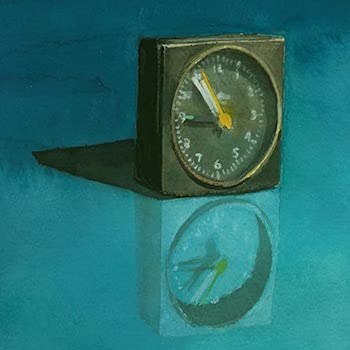Jazz Album Review: Sylvie Courvoisier and Mary Halvorson Go Time Tripping
By Michael Ullman
Guitarist Mary Halvorson and pianist Sylvie Courvoisier share a remarkable rapport on this duet album.
Sylvie Courvoisier and Mary Halvorson, Searching for the Disappeared Hour (Pyroclastic Records)

Cover art for Searching for the Disappeared Hour
Recalling her duets on this album with guitarist Mary Halvorson, pianist Sylvie Courvoisier talks about adapting her compositions to Halvorson’s sound: “When I wrote pieces for Mary, I really thought about all the possibilities of the guitar. And her music has pretty tonalities, great melodies, and a very clear sense of harmony and melody, so I love to darken it.” Halvorson also makes use of the metaphor of darkening in her comments: “We both have an affinity towards darkening things, which is great because you can start with a joyous melody and there’s all kinds of room to mess with it. We’re both really open to that. And Sylvie is great at adding harmonies and filling stuff in, so I was happy to leave space for her to do her thing, not only in the improvised section but also within the written parts.”
To my ears, their playing is, if anything, enlightened: I hear harmonic excursions to outer limits, but their interactions proffer a kind of optimistic clarity, even when they are freely developing a kernel of an idea, falling out of tempo, or dropping into sudden hushes. Their rapport is remarkable. A piece like Courvoisier’s The Disappearing Hour doesn’t sound like two musicians conversing so much as two instruments sharing the same space. The pair alternate as composers on this disc. Halvorson has written five and Courvoisier four of the numbers. They share credits on three improvised tracks.
Halvorson’s pieces, such as “Gates and Passes,” are more obviously melodic. Courvoisier often relies on repeated motives which set up a rhythmic background. Her “Disappearing Hour” begins with Halvorson playing some gently wandering single notes, which she makes sag or rise as Courvoisier enters with comparable single notes or clusters. The percussive sound of the piano leads toward an oft-repeated phrase, played at different pitches, which is then interrupted by strong chords in the bass. That rhythmically lively phrase seems to be the heart of the piece, from which the improvisers deviate. So a kind of order is established.

Guitarist Mary Halvorson and pianist Sylvie Courvoisier. Photo: courtesy of the artists.
Courvoisier’s “Lulu’s Second Theorem” begins with the composer playing another repeated phrase, with Halvorson improvising with it rather than around it. The accenting changes almost whimsically with every repetition. Eventually Halvorson takes off, darkening, I suppose you could say, the opening textures with wild, harmonically distant phrases. Adventurous as it is, their gentle playing of Halvorson’s “Faceless Smears” is lovely — even wistful — until Courvoisier initiates tart phrases high in the treble. That disturbance sets off Halvorson, who improvises before the piece falls back into its lyrical self. “Four-Point Play” is attributed to both women: it’s a restless improvisation with Courvoisier occasionally strumming the keys while Halvorson contributes train-like noises and odd glissandos. Even here, the pair fall into a kind of lyricism. “Party Dress,” another shared piece, opens with the pianist playing unpredictable single notes over Halvorson’s electronic murmur. It doesn’t sound much like a child’s excitement over getting a party dress. But then, there were no parties during Covid.
In the album notes, Courvoisier mentions the isolation of the Covid era, and the sense of time lost, as part of the inspiration for the album. So Searching for the Disappeared Hour, an hour long, is literally meant to make up for lost time.
Michael Ullman studied classical clarinet and was educated at Harvard, the University of Chicago, and the U. of Michigan, from which he received a PhD in English. The author or co-author of two books on jazz, he has written on jazz and classical music for the Atlantic Monthly, New Republic, High Fidelity, Stereophile, Boston Phoenix, Boston Globe, and other venues. His articles on Dickens, Joyce, Kipling, and others have appeared in academic journals. For over 20 years, he has written a bi-monthly jazz column for Fanfare Magazine, for which he also reviews classical music. At Tufts University, he teaches mostly modernist writers in the English Department and jazz and blues history in the Music Department. He plays piano badly.
Tagged: Mary Halvorson, Michael Ullman, Pyroclastic, Searching for the Disappeared Hour
